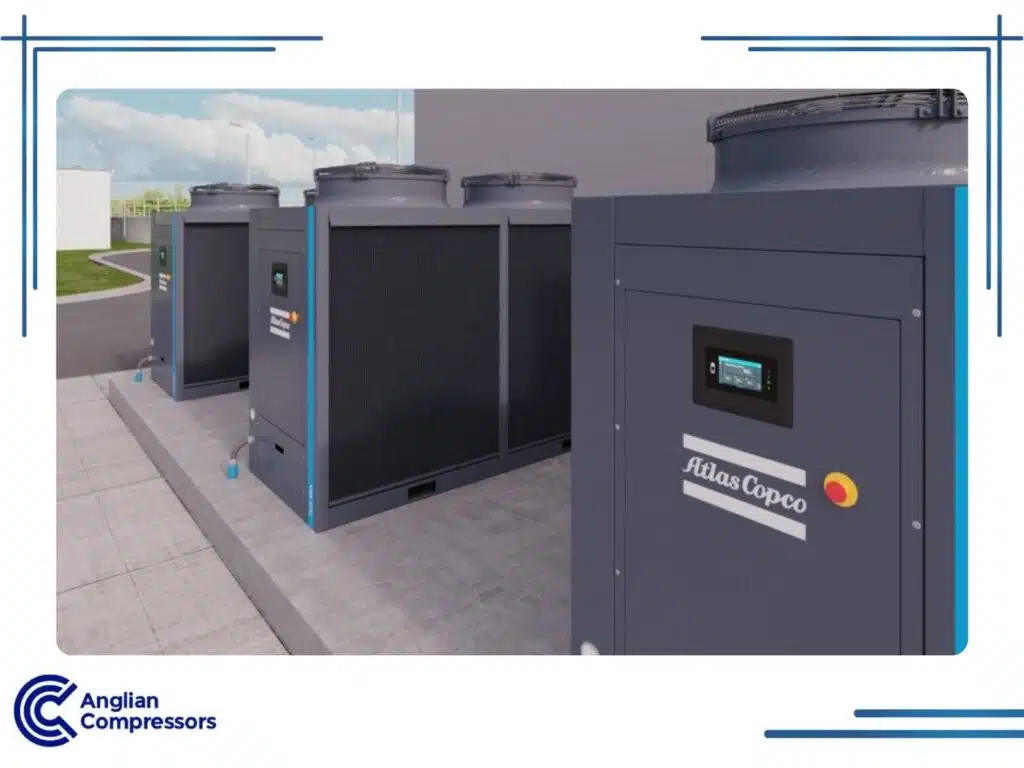How to select the right industrial chiller
Industrial chillers are critical in manufacturing plants where equipment must be maintained at a cooler temperature. Components generate heat, and if overheating, can become damaged. Similarly, equipment and machines perform better when they’re cool.
The wrong industrial chiller can lead to a cascade of costly problems to your operations and bottom line.
From air-cooled and water-cooled chillers to process chillers and portable units, there are dozens of chillers on the market to choose from. Selecting the right industrial chiller is not just about avoiding problems either – it’s also about improving your bottom line. The ideal chiller can significantly reduce energy consumption, enhance operational efficiency, and extend the lifespan of your equipment. It can even contribute to a greener footprint by minimising water usage and waste.
Atlas Copco chillers, for example, use advanced variable speed drive (VSD) technology to adapt energy use based on load, reducing costs and environmental impact.
In this guide, you’ll learn the different kinds of industrial chillers and which one is best for your business.
Understanding Your Cooling Requirements
The first step in choosing the right industrial chiller is understanding your cooling requirements. This begins with determining your heat load – which is the total amount of heat that needs to be removed from your process.
Heat load calculation involves considering factors such as the types of equipment used, the ambient temperature, and the desired temperature of your process. This might sound complicated, but there are online calculators and professionals who can help you determine your exact needs.
Once you understand your heat load, you can move on to understanding your specific equipment and process. Consider the materials being used, the speed of production, and any potential fluctuations in temperature. This will help you estimate heat generation accurately.
When calculating cooling requirements, Atlas Copco’s engineers can assist with precise thermal management and custom cooling configurations, ensuring optimal system design.
The Importance of Choosing the Right Chiller
An overperforming chiller is an unnecessary expense, while an underperforming chiller will struggle and potentially fail, leading to costly downtime. It’s about finding that Goldilocks chiller – one that’s just right for your needs.
Air cooled chillers remove the water dependence associated with water cooled chillers. Not needing access to local water supplies, or a separate external tower, helps to ensure lower operating costs. Wastewater is no longer an issue when using air cooled chillers, which eliminates major environmental concerns.
Water cooled chillers are another option. These offer persuasive efficiencies while requiring a regular water supply to function. A water pump and a tank are usually needed for these systems. However, they tend to have a longer lifespan compared to their air cooled cousins.
Atlas Copco chillers with oil-free technology ensure Class 0 certified cooling for industries like food and beverage, pharmaceuticals, and semiconductors. This level of oil-free performance guarantees product safety and system reliability.
In either case, when correctly sized and specified, chiller technology more than pays for itself in just a few years compared to not using one at all.
Specifying a Chiller Installation
Plant managers need to consider factors such as the process fluid mixture, the cooled temperatures required, pressure levels, desired flow rates, and more.
Other aspects that influence chiller selection are also the setup, and installation including where the installation is operating. Space constraints, ambient temperature, and whether elevation also affects the operational efficiency of the industrial chiller units.
- Process Fluid Performance
Cooling fluids must be compatible with the industrial chiller. The process of cooling fluid is typically a blend of propylene glycol or ethylene, combined with up to 50 percent water. This manages setpoint temperatures at the end of the range. Operators often add a corrosion inhibitor to prevent seal degradation, too.
Atlas Copco chillers integrate stainless steel centrifugal pumps, ensuring resilience against corrosion and breakdowns.
- Cooling Fluid Temperature
Setpoint temperatures alter cooling capacity with industrial chillers. As the setpoint is lowered, capacity drops. This changes which chiller is selected based on its intended purpose. To help with this, you can examine the published performance data of individual chillers.
A chiller should also tolerate the lowest ambient temperatures through the season to operate as expected.
Atlas Copco offers chillers for demanding environments that sustain efficient operation even at extreme ambient temperatures up to 46°C.
- Process Flow and Pressure Requirements
Insufficient flow rates lead to inadequate heat transfer, causing temperatures to rise. This not only compromises the quality of your products but also puts unnecessary strain on your equipment, prematuring wear and tear.
On the other hand, undersized pumps or pressure relief issues can restrict flow, forcing the pump to work harder and potentially shortening its lifespan. This can lead to costly repairs and unplanned downtime, disrupting your production schedule.
To avoid these pitfalls, it’s crucial to carefully calculate your process flow and pressure requirements. Consider all components of your cooling loop, including pumps, impellers, and seals.
- Chiller Operating Environment and Spatial Constraints
Heat dissipation by air-cooled chillers is needed to avoid overheating. The chiller operating environment is a significant factor here, and a rising ambient air temperature reduces potential heat transfer.
For chillers with a condenser relying on liquid cooling systems, the pump, compressor, and other parts may overheat should the chiller equipment get too hot. Higher ambient temperatures directly contribute to this and reduce the lifespan of affected components. Around 40-degrees centigrade is the typical maximum ambient temperature limit for many chillers, but each model varies.
Adequate air circulation space surrounding the chiller matters too. Proper airflow is needed for optimal performance, with insufficient airflow eventually damaging the chiller.
- Installation and Environmental
Where you install your industrial chiller matters. An oversized chiller uses valuable real estate in factories. In tight spaces, a compact chiller is your best bet. But remember, even compact chillers need enough room for airflow and maintenance access.
If your chiller is facing harsh conditions, such as dust, debris, or extreme temperatures, you will need some extra protection. Think air filters to keep the chiller’s insides clean and sump heaters to prevent freezing in colder climates.
Indoor and outdoor installations each have their own considerations. Indoor chillers might need additional ventilation to dissipate heat, while outdoor chillers need to be weatherproofed. Your chiller size might also change depending on whether it’s battling the elements outdoors or enjoying the comforts of an indoor environment.
Choosing the right chiller for your space and environment isn’t just about fitting it in – it’s about ensuring it operates at its best, no matter the conditions.
Maintenance, Safety, and Control
The latest industrial chillers are easier to use, safer, and smart too.
Atlas Copco’s integrated SmartLink technology offers remote monitoring and predictive maintenance insights, reducing downtime and optimising performance.
Safety tools include probes, switches, and regulators to ensure heat levels, pressure settings, and other potential concerns are monitored. Also, the refrigerant is hermetically sealed, so no gas leaks or significant issues arise. However, access to the main refrigeration system and circulation system is easily obtained via the front and rear of the chiller unit, respectively.
Atlas Copco industrial chillers also come with a touch-screen controller. Enabling one of the energy settings, which relies on sophisticated algorithms, allows the operator to reduce costs, and it’s possible to use remote monitoring too.

Conclusion
The question of how to select the right industrial chiller is worth considerable review. It’s all too easy to make a misstep when determining the size of the chiller you require. Remove the confusion over what is an optimal industrial cooling system for you, by talking with our team at Anglian Compressors. We can address your specific requirements through a detailed consultation.
Contact us below.


